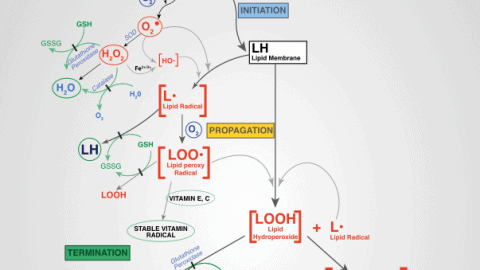The Facts on Waxy Maize, Vitargo, and other carb sources
As found on Muscular Development Magazine
© 2009 – 2012
A few years back a bunch of studies supported the concept that both the timing and type of carbohydrate athletes used could have positive effects – for both aerobic and anaerobic oriented athletes. Since then there has been a rush to find the “best” pre and post workout carb source. As is typical for the bodybuilding/fitness industry, a new “miracle” carb source burst onto the market almost monthly promising muscle growth second only to an Anadrol* enema, but I digress… The point being, there’s been a great deal of information, misinformation, and down right disinformation, regarding these “amazing miracle anabolic” carb sources. The pinnacle of which, is Waxy Maize Starch (WMS), but before we get to that, let’s back up a second to recap why the focus on these carb sources.
A Brief History…
The basic concept goes like so: Most people are aware that nutrient timing is as important as nutrient composition. In other words, it’s not just what you eat, but when you eat it that gives optimal results. As the man said, “Timing is everything.” Consuming the right nutrients at the right time can have positive effects on body composition, which can equal more muscle and less body fat as well as improved performance.
Following an intense exercise session, there’s a “metabolic window” – so to speak – where the body preferentially shuttles glucose, amino acids, and other nutrients, into the liver and muscles via both insulin-dependent and non-insulin-dependent transport mechanisms. Translated, this means your body will shuttle carbs and protein into the tissues you want (muscle) instead of storing them as fat after a workout. So far so good…
To carry the analogy further, the metabolic window doesn’t stay open indefinitely, so you need to take advantage of the opportunity while it lasts.
A number of studies have found that a post-workout drink containing high-GI carbs** is highly anti-catabolic. Adding protein to the mix – depending on the protein – has an additive effect with the two working synergistically to create an anabolic environment that’s superior to either nutrient alone.
Obviously there’s a great deal more to it, but the above is intended as a quick recap of the concept vs. an exhaustive review on the topic.
Back to Waxy Maize Starch (WMS)
So with the above brief summary of why the big interest in various carb sources pre and or post workout, we can focus for a moment on WMS. WMS has been pushed heavily as an optimal carb source with sellers claiming superior effects to other common carb sources such as maltodextrin and dextrose. Claims of faster glycogen resynthesis after tough workouts “rapid absorption” and faster gastric emptying, are the common claims made by those selling WMS. I’m sure people have also seen claims about “high molecular weight, low osmolality” and other fancy terms being thrown around also. So is any of this true, or have people been fed another over hyped poorly supported bag of goods? Let’s see…
“Just The Facts Ma’am”
One major claim of WMS is “rapid glycogen” storage after exercise compared to other carbs. One study compared WMS to dextrose, maltodextrin, and a “resistant”*** starch. 8 male cyclists were put through a workout designed to deplete their glycogen stores**** so their muscles would be primed for glycogen storage as mentioned above in the “Brief History” section. Furthermore, after feeding them these various carb sources – at 24 hours after the glycogen depleting workout program – glycogen levels were essentially the same between the WMS, dextrose, and malto. In fact – although not statistically significant – dextrose was the best of the bunch in this study for getting glycogen levels back up after the exercise protocol (1) which is what athletes should strive for after tough workouts.
Another big claim of WMS is as a pre workout carb source, but is it any better than, say dextrose? The answer appears to be NO. Ten well trained, elite male cyclists were given either WMS, dextrose, resistant starch (RS), or placebo, and their ability to sustain endurance work after ingesting these carb sources and placebo tested. Performance during prolonged endurance exercise is related to the ability to maintain blood glucose levels via glycogen storage and ingested carbs before and or during the exercise. So, these researchers wanted to see which of these carb sources consumed pre-exercise would maintain performance during prolonged exercise. That is, which carb source would fuel the greatest amount of work in the final 30 minutes. First, they gave the cyclists (at separate times) each of the carbs (about a 75 gram dose) 30 minutes before their 2-hour ride. The blood glucose and insulin response from dextrose was 3 times higher in the first 15 minutes; at 30 minutes glucose was still over 1.5 times higher while insulin remained 3 times higher. Then they did their exhaustive ride. The study found dextrose and WMS similar (although dextrose still had a slight edge) in their ability to maintain performance with RS and placebo being less effective (2). Again, WMS did not show itself to be anything special and slightly less effective then good old dextrose. This also is the first study (of several—see more below) to show WMS to be low glycemic and low insulinemic (low insulin spiking).
“So Why All The Hype, Will?”
So at this point the reader is thinking “then why all the hype over Waxy Maize, Will? Where is all this info coming from about this carb source being so great if it’s not so great?!” I feel your pain and will answer your questions! This is where things get more interesting.
The Real Deal…
A carb source that has an optimal pre and post workout profile for the resynthesis of glycogen after tough workouts, fast gastric emptying, and improved performance, has a high molecular weight and low osmolality and should spike blood glucose and insulin levels post workout. Studies suggest the best of the bunch for this purpose is a patented carb sold under the name Vitargo. What sellers of WMS have unknowingly (some might suspect knowingly…) done is use the data and claims from Vitargo and applied them to WMS, as if the two were interchangeable, with some getting the impression WMS is just a generic form of Vitagro, which is not the case. For example, sellers of WMS claim it’s absorbed rapidly, increases glycogen stores quicker than other carb sources, and improves performance (similar to Vitargo), but the studies that exist do not support that (or show the opposite…) and or simply don’t exist to support it as the studies above clearly demonstrate. What does exist, however, are studies showing Vitargo to have these effects. As I said, it appears sellers of WMS have “pirated” the studies actually done on Vitargo as if they were interchangeable carbs sources, when they are not. As already shown, WMS is, at best, about equal to maltodextrin and dextrose, or inferior to those carb sources, depending on which study you read. For example a study just completed –and soon to be published- out of Purdue University, found WMS had a 3 times lower glucose response compared to maltodextrin, and a 3 times lower insulin response, and even 2 times lower than white bread! (3) So even white bread appears to be a superior post workout carb source than WMS if one is looking to spike glucose and insulin levels, which leads to enhanced rates of glycogen storage and anti-catabolism. It’s interesting to note that WMS has been shown to have such a slow and steady effect on glucose and insulin levels, scientist now routinely refer to it as “slow digesting” or “low glycemic.”
So What Of Vitargo?
Vitargo is an interesting starch carbohydrate with some interesting properties. A study published in 2000 compared Vitargo to maltodextrin plus sugars and their respective effects on glycogen storage after an exhaustive exercise protocol and found Vitargo to be far superior to malto/sugars for rapidly replacing muscle glycogen levels both two and four hours after the exercise sessions (4). By “far superior” I mean 70% better over the 2 hour period, which is no small amount.
A follow up study published in 2008 found similar effects, but with some additional twists in support of Vitargo as a unique carb source. This study found that Vitargo was superior for performance during a subsequent bout of maximal exercise just 2 hours after glycogen-depleting exercise. In a nut shell, on three randomized visits 8 guys were put through an exercise protocol designed to use up a bunch of their stored glycogen (ergo, they were glycogen depleted), and then fed 100g of either Vitargo, malto/sugars, or flavored/artificially sweetened water as control. They waited 2 hours and tested their performance (ability to do “work”) via a 15 minute high intensity time trial test on a cycle ergometer and found the group that had been fed the Vitargo right after the prior workout 2 hours before had superior performance for the second high intensity trial. This makes perfect sense; if Vitargo rapidly replaces glycogen levels in muscle and the liver, the person will be able to perform better during their next exercise session, especially if those bouts of exercise are within the same day. If glycogen levels are not boosted back up by the next exercise session, performance will suffer. As the authors of this study summarized well:
“Limiting factors to post-exercise muscle glycogen re-synthesis following carbohydrate feeding include the amount, timing, and form of carbohydrate administered, the rate of gastric emptying and intestinal absorption of the ingested carbohydrate, glucose storage and output by the liver, and muscle glucose transport and oxidation.”
Translated, it’s not as simple as just the carbohydrate’s glycemic rating or whether it’s a “simple” or “complex” carb. There are a lot of other factors involved and science has come a long way in understanding what those biological factors are.
Gastric emptying rates are another important issue to athletes as the faster it leaves the stomach the faster it enters the intestines where it is digested and absorbed. Fast gastric emptying and digestion means the faster glucose levels, insulin spikes, and subsequent glycogen storage and enhanced post workout anti-catabolic action, not to mention no one enjoys having a drink sloshing around in their stomach during or after a workout. It’s just unpleasant and if it’s sloshing around in your gut it’s not doing squat for your muscles! A 2000 study compared the gastric emptying rates of Vitargo to a carb source derived from maize starch and found Vitargo “significantly” faster emptying rate from the stomach, which would partly explain why Vitargo appears to replenish depleted glycogen levels so quickly when compared to other carb sources (5).
Conclusions
In the above review, I was trying to keep the science mumbo jumbo to a minimum. So what’s the take home on the above?
• For endurance athletes and people following multiple sessions per day in the gym, Vitargo is a no brainer as the pre/post workout carb source of choice. For those focused exclusively on gaining lean body mass (LBM) and strength, doing traditional programs where a single exercise session is done in day lasting an hour or less, it’s unclear at this time if Vitargo is going to have additional benefits on body composition above and beyond what malto or dextrose can achieve as this has not been studied. In theory however, faster gastric emptying, higher and faster insulin spikes, and enhanced rates of glycogen resynthesis, etc., should be beneficial to strength athletes following traditional programs, but more data is needed. Bottom line here is if I was looking for the least expensive carb source pre/post workout, I would use malto and or dextrose. If I wanted to use what appears to be the most efficient carb source that data suggests has superior properties for athletes, I would use Vitargo. WMS however is a bust and would not even be in the running between those choices in my view.
• It’s easy to see why people are often confused regarding WMS vs. Vitargo, and why sellers of WMS have taken advantage of that fact. Vitargo can be derived from WMS, so they are essentially the same thing right? Wrong. Vitargo can be derived from WMS, potatoes, rice, wheat, and other sources, so even if WMS is used as the starting source, it’s a very different starch as the finished product. If one reads the patent on Vitargo***** there is a very interesting statement made which is on testing, “it will be found there have occurred novel types of bonds which do not occur traditionally in native starch.” What that means is, it’s a starch not normally found in nature and is structurally and functionally different than the starch source it was derived from. A true “designer starch” if you will, which appears to be optimally designed to favor the rapid formation of glycogen.
The Brink Bottom Line: More data is needed in my view on Vitargo to answer some lingering questions, but it’s one of the few products out there with more substance than sheer hype (which is more then can be said for WMS…) with Vitargo firmly in the “might be worth a try” category hovering on “definitely worth using” if/when additional studies are done to confirm/support some of my previous comments and questions above.
See you in the gym….
Citations:
(1) Jozsi A.C. et al. The Influence of starch structure on Glycogen Resynthesis and Subsequent Cycling Performance. Int. J. Sports. Med. 17: 373-378. 1996
(2) Goodpaster B.H. et al. The Effects of Pre-Exercise Starch Ingestion on Endurance Performance. Int. J. Sports Med. 17: 366-372. 1996.
(3) Author communication.
(4) Piehl K. et al. Muscle glycogen resynthesis rate in humans after supplementation of drinks containing carbohydrates with low and high molecular masses. Eur. J. Physiol. 81: 346-351. 2000
(5) Leiper J. B. Improved Gastric Emptying Rate in Humans of a Unique Glucose Polymer with Gel-forming Properties. Scan. J. Gastroenterol. 11: 1141-1149. 2000
Notes:
*= Anadrol, the brand name for a powerful oral anabolic steroid.
** = The GI of a carb is not the only factor responsible for the benefits of various post/pre workout carbs.
***= A “resistant starch” is resistant to digestive enzymes that break down starch into glucose for absorption. This study used a resistant starch that was 100% pure amylose.
**** = 60 min cycling at 75% VO2 max followed by 6X 1min sprints at 125% VO2 max with 1 minute rest between sprints.
***** = US Patent # 5,929,052
Will Brink is the owner of the Brinkzone Blog. Will has over 30 years experience as a respected author, columnist and consultant, to the supplement, fitness, bodybuilding, and weight loss industry and has been extensively published. Will graduated from Harvard University with a concentration in the natural sciences, and is a consultant to major supplement, dairy, and pharmaceutical companies.
His often ground breaking articles can be found in publications such as Lets Live, Muscle Media 2000, MuscleMag International, The Life Extension Magazine, Muscle n Fitness, Inside Karate, Exercise For Men Only, Body International, Power, Oxygen, Penthouse, Women’s World and The Townsend Letter For Doctors.
He’s also been published in peer reviewed journals.
Will is the author of the popular e-books, both accompanied by private members forum access , Bodybuilding Revealed & Fat Loss Revealed.
You can also buy Will’s other books on Amazon, Apple iBook, and Barnes and Noble.










I’ve used Vitargo with some success in the past. Its certainly better than just downing any sugarry carbs you find right after your work-out.
I am astounded though by how many large supplement companies are coming out with WM products (Volumaize, etc)
Darion, the feedback on Vitargo is generally very good I find.
Darion,
I agree with Will… In my experience, VItargo is the real deal and the only real deal.
Having moved into a pretty intensive cycling habit–as in riding a lot–I have come to know and appreciate the importance of carbs. I’m prone to ride a hundred (to two) miles a week with a weekend ride of 50-80 miles… and can burn 1500 cals an hour. There’s no other carb source that comes close to getting as much fuel in without any stomach upset as Vitargo.
I’ve also found it provides a massive kick for Strength.. the pump makes NO seem like the crap it is… for me.
Thanks for sharing this info Will.
Shawn
Will, when I asked you about creatine use for a 5K racer you suggested I look at Vitargo. Would you suggest Vitargo CGL which has 10 g creatine and 70 g Vitargo?
Has research (3) been published?
Great Info! Thank you.
Have a blessed day!
Vitargo is what I need.. But is the only way of obtaining in supplement form?$$
I chow down a bunch of simple sugars and ineffective p/workout drinks… Now I must google Vitargo p workout drinks see what I can find…any suggestions ?
Being new to the sport, what I find is a determining factor in choice with Vitargo is cost – it costs a lot more than a tub of maltodextrin or Waxy Maize. Is there a cheaper source for the components in Vitargo?
If you read the article on Vitargo fully, you will find my opinion there. Vitargo makes sense for some, probably not needed for others, and much less costly sources are recommended in the article for those cheaper sources make sense until further studies exist. Good luck!:)
Hi Will,
I’m using maize starch for quite a while now and i’m very happy with it. Let me tell you why.
Dextrose is a very fast sugar witch gives a very high bloodsugarspike and therefor a very high insuline spike. Your body wants to get rid of the too big amount of bloodsugar and will bring it anywhere and also tot your fatcells, so you create if you’re on a high caloric diet more storage of fat and you’ll get extra waterretention. Only the guys in a low caloric diet won’t get extra storage of fat and water.
By using WMS you won’t get any bloodsugarspike at all and also no insulinespike. It’s no sugar….it’s glycogen (poly-glycogen or amylo-pectin)
All users I know have the first weeks of use the following feeling after heavy workout: in about 45 to 60 minutes they feel like their muscles are growing to explode. Same as a high dose of vitargo will give you. Another thing they get is that they get leaner during the intake of WMS or maize starch. No extra fat or water retention, but they get dry from using WMS, even with a higher caloric diet.
I’m not a big fan of dextrose, in fact, i think most carbs are superior to dextrose because of the extra fat and water retention.
If there’s any long term research done by bodybuilders and the effects of dextrose vs wms i sure like to read the results.
Greetings,
Martin
If I want a carb source that is best for post workout glycogen resynthesis, and other effects of high GI carbs, I’d use as mentioned above. If I want low GI carb sources, I’ll use whole food sources such as eat oatmeal, yams, etc. WMS poor $$$ used in my view, and devoid of nutritional value to boot. Many people don’t bother at all with using high GI carbs as PWN, and will simply use whole food low GI carbs, which is fine too. WMS makes no real sense anyway you look at it, but if you feel it works for you, rock on. I just gives the science based info as it exists. 🙂
Hi Will,
I am currently on a low calorie diet but will soon be reverting back to normal as I only need to lose a few lbs. Would you say mixing instant oats with whey protein (concentrate/isolate) would be a good solution for those who don’t want to pay the $$$ for Vitargo?
Thanks,
Aaron
Came to this post via your “post-workout-carb-facts” post…I know this comment isnt directly related to the current post, but ive been a long time reader and lurker… this is the first time im posting on your blog. And i know you would advise me to talk to a doctor, but ill still ask. Im prediabetic and have a good hba1c profile ( good control 6.1). My question is whether i can use vitargo along with my current BCAA’s. Ive always taken BCAA’s post workout, but being pre-diabetic have never taken maltose or dextrose as a insulin spike would not be good for me right? and at times i think that people who arent diabetic/per-diabetic are going to end up with diabetes if they load up on high GI carbs like this… am i right?
Any way i can optimize my “metabolic window”?
Thanks
It’s hard if not impossible to really advise you on that, as it’s a medical question by nature. There are some very successful athletes who are diabetic, so it can be done. However, I’d advise against using Vitargo in your case. If you did use it. I’d recommend trying very small amounts and seeing how you responded, but as a diabetic, control of glucose is essential and using carb sources that have big fluctuations on glucose possibly risk to benefit not worth it.
Can you compare Vitargo and Karbolyn? Which do you think is more effective and a better carb overall?
im no expert but it sounds like these companies are out for one thing the $$ . just eat right train hard get the right amount of rest and learn how your own body responds to food different exercises reps and save your money for your retirement not the supplement companies. thanks for reading . train hard
Great Article Will Thanks!!
Another brilliant summing up of the why and wherefores of supplements great work Will ,, it all seems so much clearer when you do it,,, thanks ,pete
I have heard that Vitargo was the more effective of the two. Thanks for the informative article, Will.
Myself, I just have a Hershey bar with almonds and a whey shake. Good nitro blast from all that arginine and the whey can replace energy if nec.
Warren
Hi Will. From a molecular perspective, how is it possible that Vitargo have such a high molecular weight? Compared to other hydrolyzed starches, Vitargo claims to have 500 000-700 000 Da while other starch might only have 7500 Da?
Vitargo is an “engineered” carbohydrate product, meaning that it does not exist in Nature.
That’s the one thing that concerns me about it.
We are all moving towards more “natural” foods…it’s a little odd to then bung in a synthetic carbohydrate that has no long-term safety studies behind it.
how is Vitargo compared to UCAN?
Thanks for the article Will… I’ve recently picked up a jug of vitargo on a friends recommendation.. Exciting stuff to read here… I’ll give it a go… and see how it compares to Maltodextrin.
Regards…
Brilliant article Will. I’m a big supporter of Vitargo and your article summed it up perfectly. The supplement industry is filled with 99% bulls**t supplements that delivery next to no results. Let the science do the talking! Next time you pick up a supplement look for the science reference or write to the company and ask them to send you their research on the product. The chances are they won’t have anything.
Thanks again Will for spelling it out as a it is. Present the facts and let the individual decide. Cheers